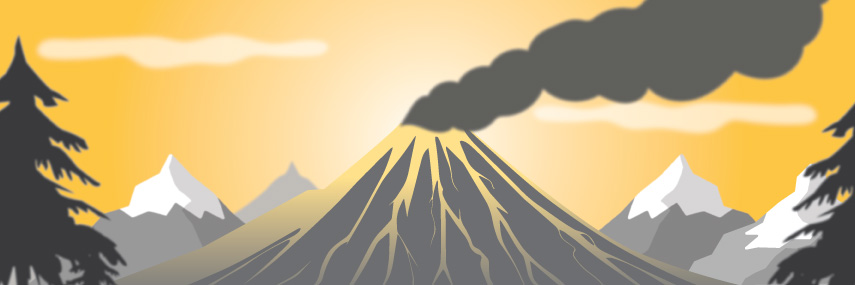Get prepared for volcanic activity

Volcanic eruptions in B.C. are rare and usually come with warning signs. When they do occur, they can cause significant local damage and release harmful ash over thousands of kilometres. It’s important to know what to do before, during and after a volcanic event.
On this page
- Know the risks
- Get prepared before a volcanic event
- Stay safe during a volcanic event
- Recover after a volcanic event
Know the risks
B.C. has 26 volcanoes and volcanic fields. There are also volcanoes in nearby locations like the Yukon, Alaska, Washington State and Oregon. One notable volcano is Mount Baker, just south of the U.S. border. Use ClimateReadyBC's volcano map to see which volcanoes are closest to you.
A volcano is an opening in the Earth’s surface where lava, gases and ash come out. Over time, these erupted materials pile up and form volcanic mountains. Some eruptions are small, while others are powerful, depending on factors such as the lava’s makeup and gas content.
Volcanoes can cause several hazards including:
- Lava: Hot, melted rock that flows downhill
- Pyroclastic flows: Fast-moving, superheated flows of rock, ash and gas
- Lahars: Mudflows made of volcanic debris
- Ash: Fine particles that can spread far, affecting air quality and travel
- Explosions and gases: Harmful bursts from a volcano
Volcanic earthquakes may also occur. They are usually too small to feel, but help scientists understand what is happening beneath a volcano. Tsunamis can occur if a volcano is next to or under a body of water.
Volcanic eruptions in B.C.
Eruptions in B.C. don’t happen often, and there are usually warning signs. These include gas emissions, increased frequency of earthquakes, and changes in the land around a volcano. The last eruption in B.C. happened about 150 years ago at Lava Fork in the northwest.
Dangers of volcanic ash
While most volcanic hazards affect the immediate area around a volcano, ash can travel thousands of kilometers and cause:
- Respiratory issues
- Poor visibility
- Slippery roads
- Damaged crops
- Water contamination
- Metal corrosion
- Damage to buildings, machinery and electronics
Although ash may cause significant property damage and the clean-up can be expensive, exposure to ash rarely endangers human life, except in certain situations such as a roof collapse from thick ash buildup or a traffic incident due to reduced visibility.
Get prepared before a volcanic event
To prepare for nearby volcanic activity:
- Develop an emergency plan
- Put together your emergency kit
- Have grab-and-go bags ready in case you need to leave quickly
- Learn about volcanoes in your area and their potential dangers
- Learn about local evacuation routes
- Find out where to get emergency instructions and volcanic activity updates. Sources include your local government or First Nation and EmergencyInfoBC.ca
To prepare for falling volcanic ash:
- Develop an emergency plan
- Have a home emergency kit with goggles, masks, plastic wrap for electronics and cleaning supplies such as a vacuum cleaner and shovel
- Know where to get emergency instructions and updates from trusted sources, like your local government or First Nation and EmergencyInfoBC.ca.
Stay safe during a volcanic event
If you are in an area near volcanic activity, follow all directions from your local government or First Nation officials. They will provide information on evacuations, sheltering-in-place and restricted travel.
If you must evacuate your home, do not return until told it is safe to do so. Never approach an area where there is volcanic activity.
Protect yourself from falling volcanic ash
If falling volcanic ash is expected in your area, minimizing exposure is the best way to protect yourself.
When volcanic ash is expected but is not yet falling:
- Return home if possible
- Disconnect downspouts from gutters and disconnect any tanks from rainwater collection systems as volcanic ash can contaminate water supplies
- Close all outside and inside doors and windows
- Close all dampers
- Place damp towels at door thresholds and other draft sources
- Tape drafty windows by using duct or other wide tape
- Protect sensitive electronics
- Move pets and animals indoors
- Keep medications close by
- Follow directions from local authorities and emergency officials
When volcanic ash is falling:
- Go indoors and stay there
- Do not use kitchen or bathroom vents
- Do not use fireplaces
- Do not operate the clothes dryer
- Turn off all fans, heating and air-conditioning systems to avoid drawing in air from outside
- Do not wear contact lenses if exposed to ash
- Use clean-up methods that avoid further spreading of ash indoors (e.g. careful vacuuming or damp rag techniques rather than dry dusting). Be careful to avoid further ash contamination during the emptying, cleaning, and maintenance of vacuum equipment
- If exposed to ash indoors or outdoors, protect yourself by covering your nose and mouth with a mask, cloth or handkerchief.
- If there is a lot of volcanic ash in your water supply, allow the ash to settle then use the clear water. Do not use your dishwasher or washing machine
- If you are unable to take shelter in your home, seek other shelter such as in a car or building
Recover after a volcanic event
If you have evacuated your home, do not return until your local government or First Nation officials have said it is safe. When falling volcanic ash has stopped and local officials no longer require you to remain indoors, cleanup can start, but ash can still be hazardous. Follow all clean-up instructions from your local government or First Nation officials.
